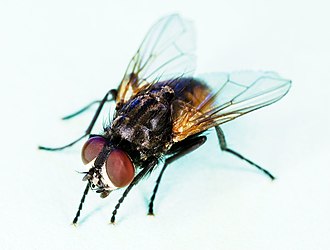Housefly

The housefly (Musca domestica) is a fly of the suborder Cyclorrhapha. It is believed to have evolved in the Cenozoic Era, possibly in the Middle East, and has spread all over the world as a commensal of humans. It is the most common fly species found in houses. Adults are gray to black, with four dark, longitudinal lines on the thorax, slightly hairy bodies, and a single pair of membranous wings. They have red eyes, set farther apart in the slightly larger female.
The female housefly usually mates only once and stores the sperm for later use. She lays batches of about 100 eggs on decaying organic matter such as food waste, carrion, or feces. These soon hatch into legless white larvae, known as maggots. After two to five days of development, these metamorphose into reddish-brown pupae, about 8 millimetres (3⁄8 inch) long. Adult flies normally live for two to four weeks, but can hibernate during the winter. The adults feed on a variety of liquid or semi-liquid substances, as well as solid materials which have been softened by their saliva. They can carry pathogens on their bodies and in their feces, contaminate food, and contribute to the transfer of food-borne illnesses, while, in numbers, they can be physically annoying. For these reasons, they are considered pests.
Houseflies have been used in the laboratory in research into aging and sex determination. Houseflies appear in literature from Ancient Greek myth and Aesop’s The Impertinent Insect onwards. Authors sometimes choose the housefly to speak of the brevity of life, as in William Blake’s 1794 poem “The Fly”, which deals with mortality subject to uncontrollable circumstances.[1]
Adult houseflies are usually 6 to 7 mm (1⁄4 to 9⁄32 in) long with a wingspan of 13 to 15 mm (1⁄2 to 19⁄32 in). The females tend to be larger winged than males, while males have relatively longer legs. Females tend to vary more in size[2] and there is geographic variation with larger individuals in higher latitudes.[3] The head is strongly convex in front and flat and slightly conical behind. The pair of large compound eyes almost touch in the male, but are more widely separated in the female. They have three simple eyes (ocelli) and a pair of short antennae.[4] Houseflies process visual information around seven times more quickly than humans, enabling them to identify and avoid attempts to catch or swat them, since they effectively see the human’s movements in slow motion with their higher flicker fusion rate.[5][6]
Housefly mouthparts, showing the pseudotracheae, semitubular grooves (dark parallel bands) used for sucking up liquid food
The mouthparts are specially adapted for a liquid diet; the mandibles and maxillae are reduced and not functional, and the other mouthparts form a retractable, flexible proboscis with an enlarged, fleshy tip, the labellum. This is a sponge-like structure that is characterized by many grooves, called pseudotracheae, which suck up fluids by capillary action.[7][8] It is also used to distribute saliva to soften solid foods or collect loose particles.[9] Houseflies have chemoreceptors, organs of taste, on the tarsi of their legs, so they can identify foods such as sugars by walking over them.[10] Houseflies are often seen cleaning their legs by rubbing them together, enabling the chemoreceptors to taste afresh whatever they walk on next.[11] At the end of each leg is a pair of claws, and below them are two adhesive pads, pulvilli, enabling the housefly to walk up smooth walls and ceilings using Van der Waals forces. The claws help the housefly to unstick the foot for the next step. Houseflies walk with a common gait on horizontal and vertical surfaces with three legs in contact with the surface and three in movement. On inverted surfaces, they alter the gait to keep four feet stuck to the surface.[12] Houseflies land on a ceiling by flying straight towards it; just before landing, they make a half roll and point all six legs at the surface, absorbing the shock with the front legs and sticking a moment later with the other four.[13]
